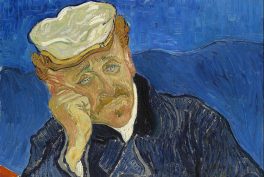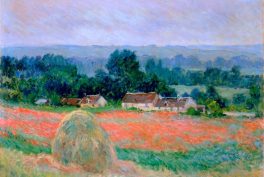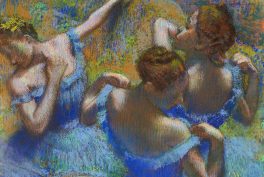As a young man, Degas traveled to Italy to complete his training. While in Florence he painted the family portrait of his father’s sister, Laure. Laure was married to the Italian baron Bellelli and had two children Giovanna and Guillia, who were respectively 7 and 10 at the time the portrait was painted.
In this very interesting—if a bit claustrophobic—portrait, the mother stands erect and impassive with an air of serious authority. She is fully dressed in black because she is in mourning for her father, whose portrait can be seen next to her head. On the other hand, the baron seems more relaxed and aloof. He sits in an armchair looking at his family, with his back almost to the viewer.
The daughters are a mix of their parents’ dispositions. The older one resembles her mother, standing poised and dignified with her hands clasped on her lap. The younger daughter is looking outside the painting. Something has caught her attention, and she playfully crosses her legs, signaling that she still is a child and doesn’t heed adult conventions.
Everything in the painting exudes an air of oppression and isolation. There is tension within this family and each person seems lost in their thoughts. This is reinforced by the games Degas is playing with perspective. An open door to the left suggests a route out of this oppressive room. Likewise, the mirror shows a window but the curtains are drawn.
2. The Millinery Shop
During the 1880s Degas created many drawings, pastels, and paintings with this subject. This one is the largest of them all. It shows a young woman admiring or working on a hat. It seems that Degas purposefully left the identity of the girl ambiguous. Is she a customer or a shop-girl? Upon closer inspection, we see that she has a pin in her mouth and wears a glove to protect the hat’s fabric, so maybe she is working on the hat and not simply admiring it. Next to the woman, there is a still life of colorful hats.
The most interesting part of the painting is its unusual angle and cropping. The angle is from above like someone is standing near the table watching the girl. On her part she seems oblivious to the observer, fully engrossed in her work.
3. A Cotton Office in New Orleans
Edgar Degas was the only French Impressionist painter to travel to the USA and paint there. In 1873 he visited his family in the States and the Cotton Office is the result of his stay there. The painting depicts the interior of his uncle’s company in New Orleans. Degas’ uncle along with his brothers and various employees of the company are depicted as they work or have a moment of rest. In the background, we can see raw cotton on a table.
In his letters to friends in France, Degas complained that during his American visit, he wanted to paint some family portraits but was unable to for various reasons. However, the cotton office is a kind of family portrait since he depicts the men of his family.
It has been suggested that there is an allusion to the life cycle of cotton. We can see the raw material on a table and in a chair next to Degas’ uncle in the foreground. Cotton as a textile is represented in the crisp white shirts the men wear and a painting of a steamship in the top right corner alludes to the transportation of cotton around the world.
4. At the Races in the Countryside
Degas presents a snippet of modern life in this painting. Despite the title, the races can only be glimpsed in the far background. In the foreground, we see an upper-class family on a horse carriage. The races seem to be completely forgotten as everyone, even the dog, has their attention on a small baby: the father, the mother, who is holding a parasol, and a wet nurse, with her breast exposed, ready to feed the baby. Everything points to the wealth and the high status of this family, from their clothes to the dog, to the fact that they can afford to hire a wet nurse.
Another interesting fact is the juxtaposition of the two women. The mother, who belongs to the upper class is fully clothed and protects her complexion from the sun with a parasol on the one hand, and the working class wet nurse that stands semi-clothed in a public space. At the time public breastfeeding was not the norm at all.
Synthetically, Degas is trying to give the impression of looking at a photograph by cropping the wheels of the carriage and the legs of the horses. Photography was the new invention of the time and a major inspiration to the Impressionists in their quest to capture the fleeting nature of life.
5. Visit to a Museum
What a modern scene! Two women admire the gilt-framed paintings at a museum. One is seated taking a glimpse in the guidebook as she looks at the artworks. The other is standing, her hand at her waist, gazing intently at the paintings. She seems entranced with the art and lost in her thoughts. The models for this piece are Mary Cassatt and her sister. Cassatt was a painter, a member of the Impressionist movement, and a lifelong friend of Degas.
Degas masterfully captures what every art lover already knows. Visiting a museum is both a wonderful experience but also a taxing one. The women are enjoying themselves, but their body posture reveals that they are a bit tired also. The movement of their bodies is what is most of interest for Degas in this piece. We notice that the painter has blurred the artworks the women admire. The art is not important. What’s important is the reception of it by the two women and the reality of their experience during their visit.












